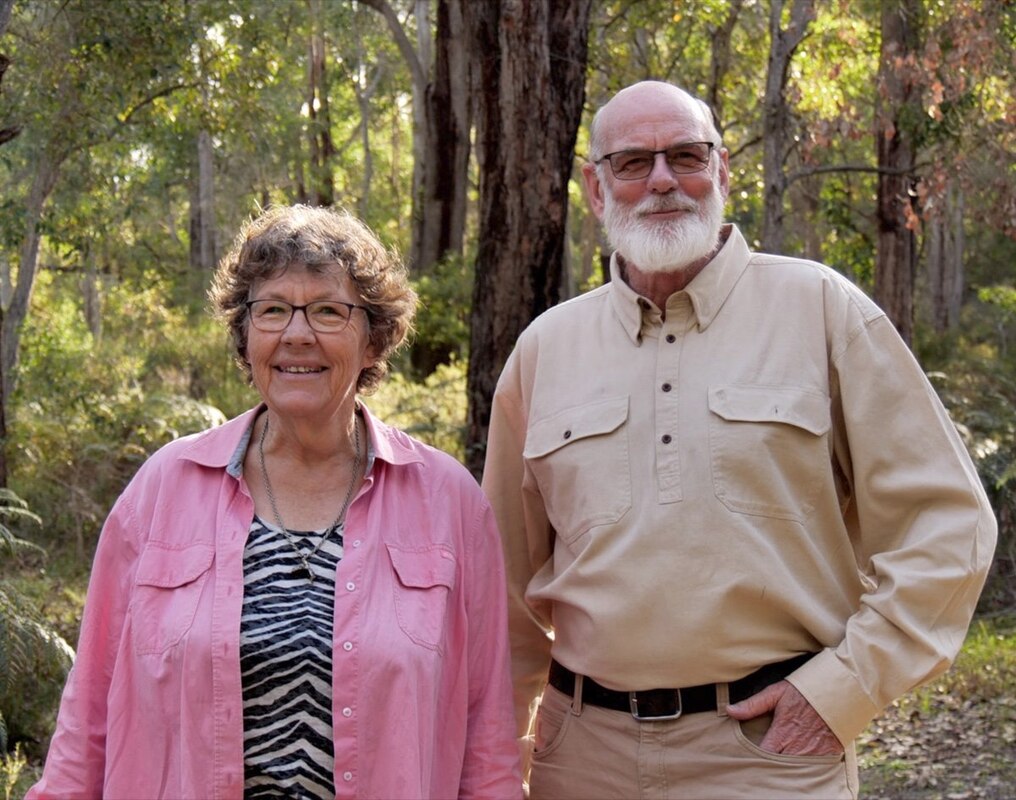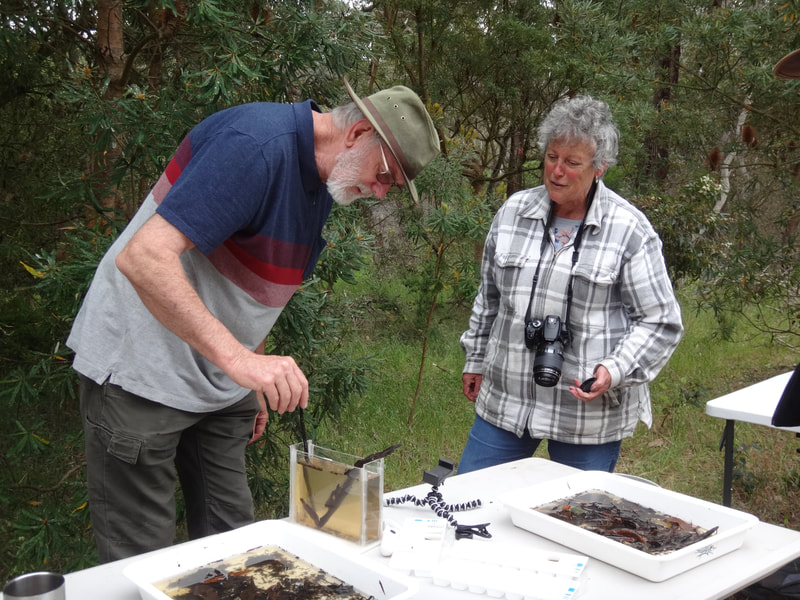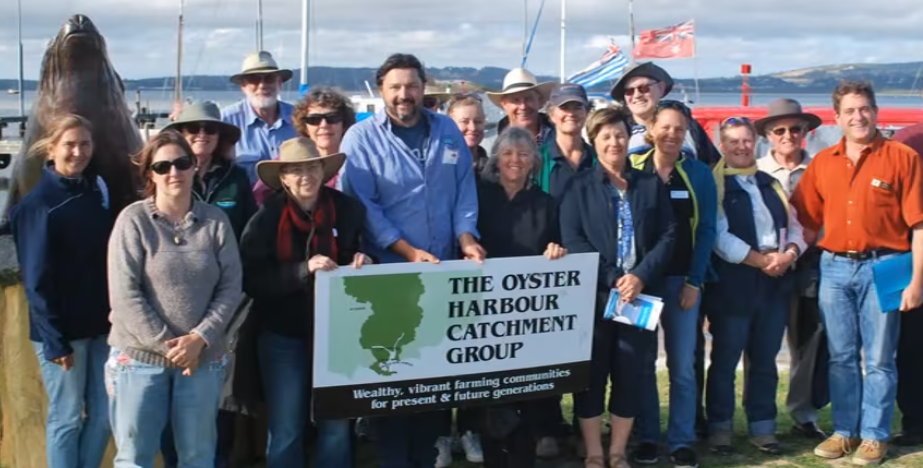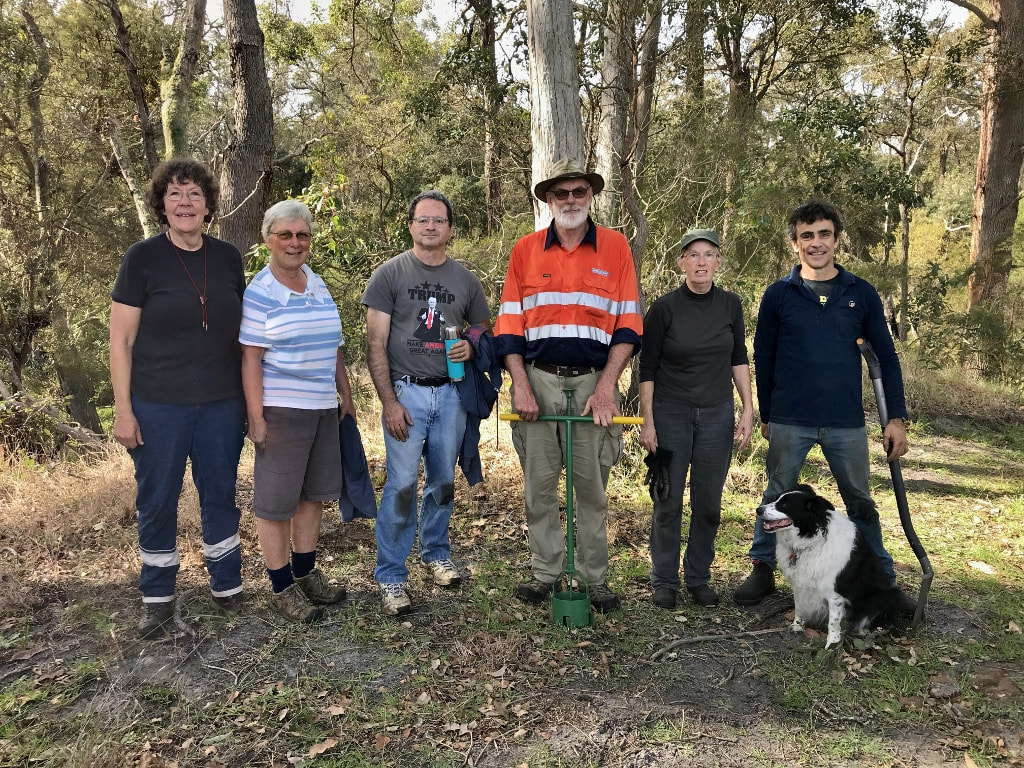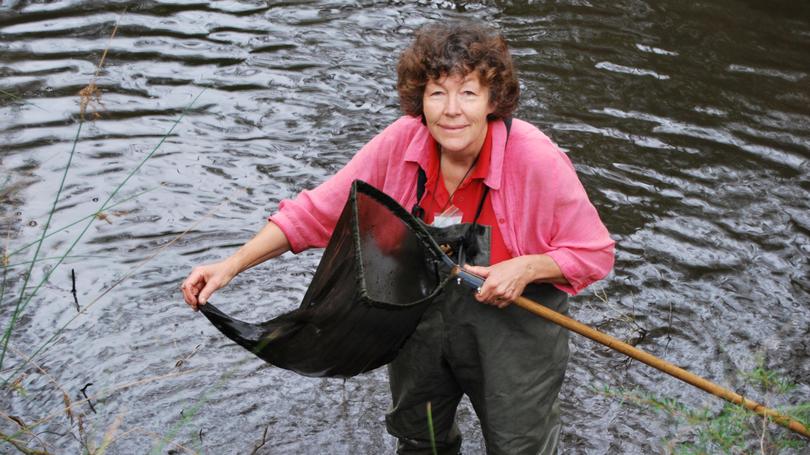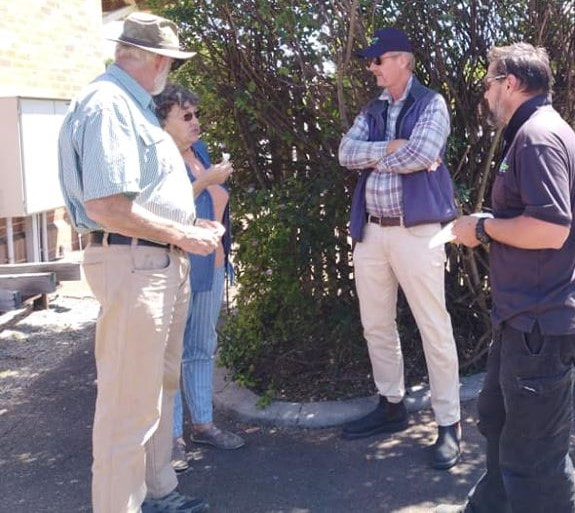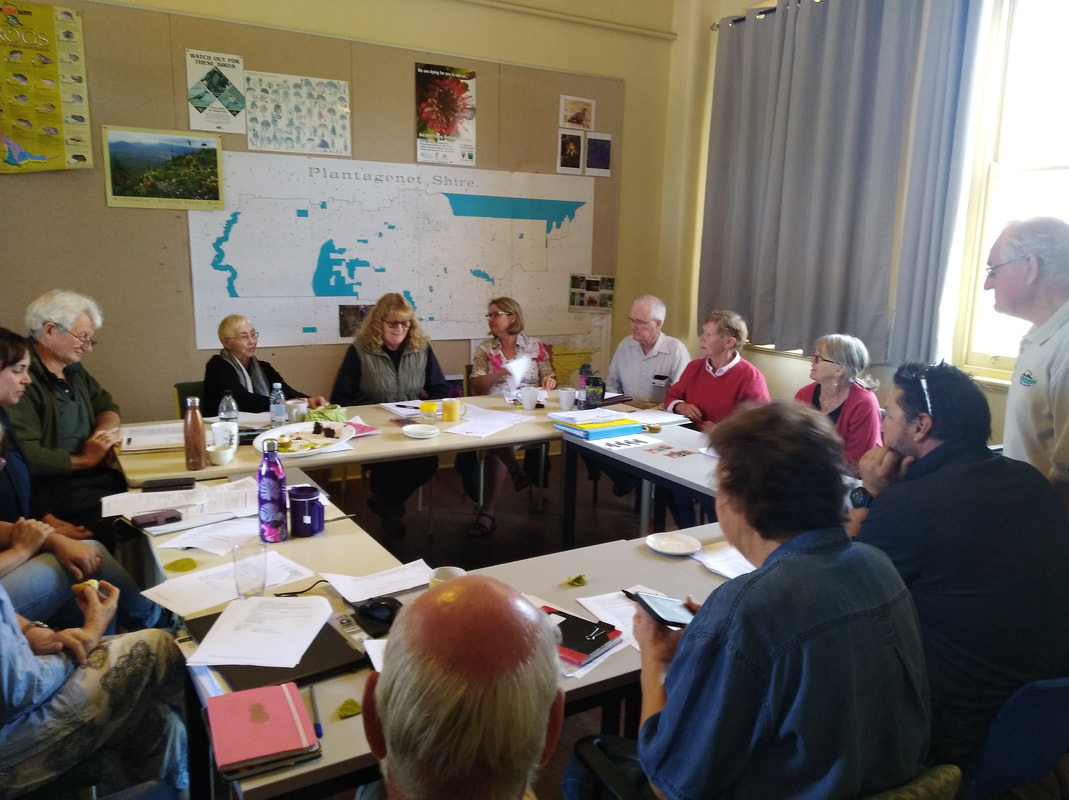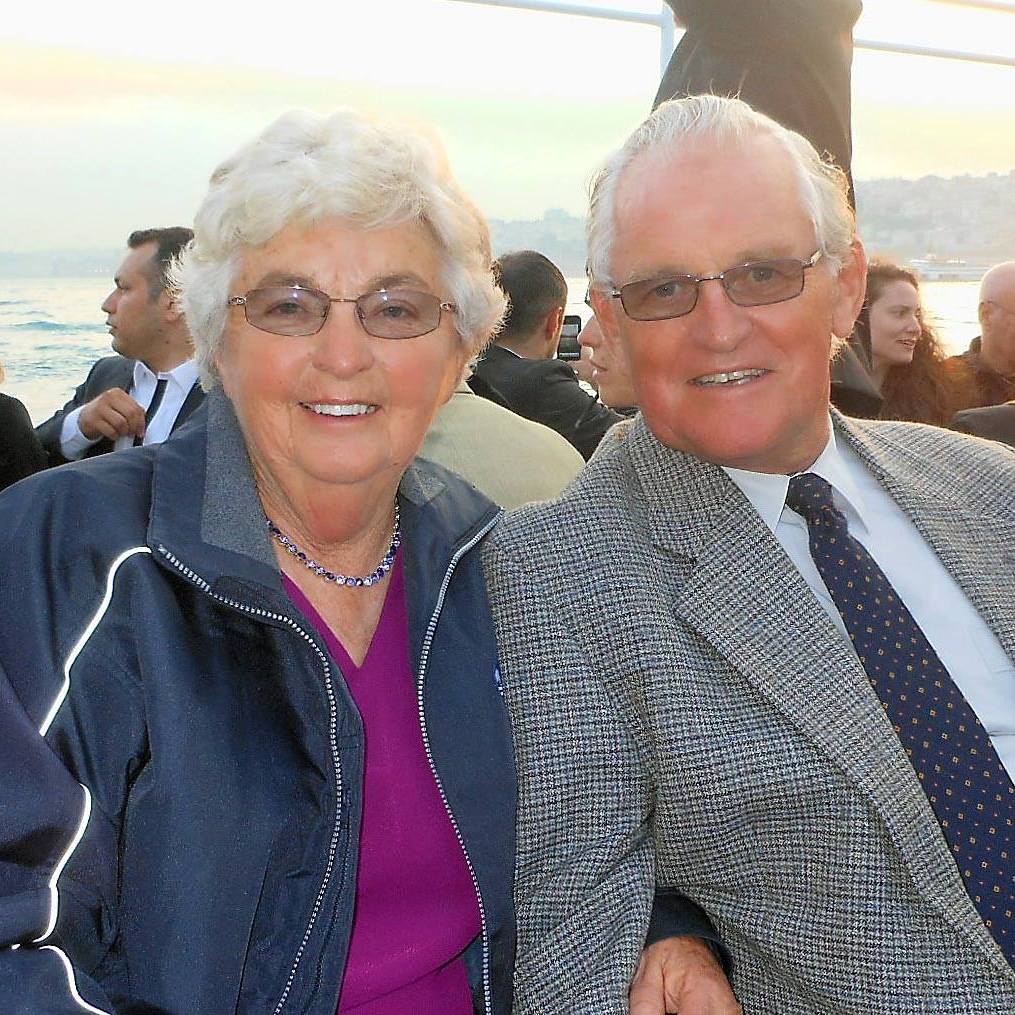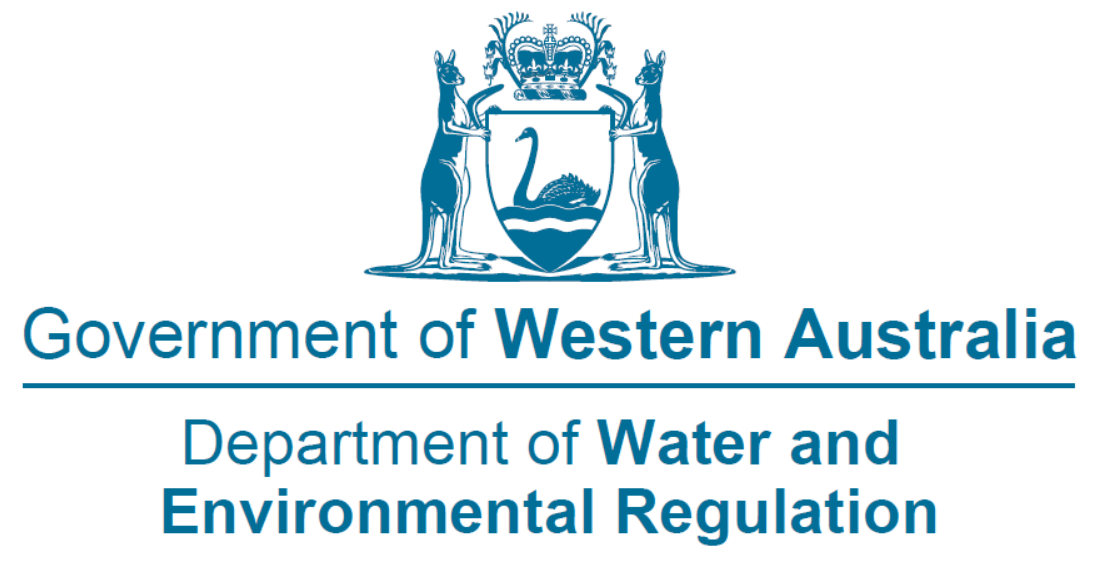An Honorary Life Member of Oyster Harbour Catchment Group is an individual who has made an outstanding contribution to the catchment's Natural Resource Management over several years. Individuals are invited by the committee to become Honorary Life Members in recognition of services provided to the group and community.
|
Vertical Divider
|
2023- Steve and Geraldine Janicke
The Janicke's have been involved with the OHCG in various ways since the mid 1990’s, initially, Steve worked supervisor and an environmental officer with the then Waterways Commission and worked with the Albany Waterways Management Authority. They both greatly enjoy the outdoor environment and have managed to combine that with their careers in natural resource management with an emphasis on how we understand and value our unique South Coast river systems. Their investigations have involved assessing their ecological status and considering the management and monitoring issues. You can see these reports in resources and online at www.janicke.com.au/ They have a passion and appreciation of river and wetland values across the community at the regional, state, and national levels. Both have given a lot of their time to participate in, teach and encourage others to be part of exploring and caring for these systems and world. Going the extra mile to advise on conservation action throughout the South Coast. |
Natural Resource Management
and the Oyster harbour Catchment Group
- Hindsight and foresight
By Steve Janicke, 2023
and the Oyster harbour Catchment Group
- Hindsight and foresight
By Steve Janicke, 2023
Geraldine and I are stepping down from the OHCG committee at this AGM but plan to remain as ordinary members. We would like to thank committee members and staff for an exhilarating journey together over the years. The usual reasons for a person stepping down from a position on a committee are relocation, a change of occupation, or ageing. All three have appeared on our radar. Aging is the tricky one and carries a sense that what can be
contributed has been contributed. For ourselves, we have not decided to retire from engagement in NRM initiatives, but are wanting to revisit our former engagement at a regional South Coast level, although less intensive from a project perspective. Stepping down is not an easy thing to do since a lot of emotional energy has been invested and there’s usually a lot of ongoing business and goals one would like to see wrapped up. So, it seemed a good time for me to engage in a bit of hindsight as a basis for some speculative foresight. I say ‘speculative foresight’ because managing our landscape is one of those strange missions which involves many people with a multitude of disparate aspirations. In this sense, an NRM group does not so much manage the landscape as try to influence and support those who do.
Leadership succession and the need to make room for the next generation eventually turns up on the agenda. This will mean the likelihood of the group branching off with a different emphasis mix, even if the basic values of the group remain much the same. It’s not just a case of passing a specific baton on. An organisation will transform itself in some way or else fade away and it is the reinventing which can attract new people. Reinventing in turn means additions, if not changes to core business and there is not just one core business.
The natural environment presents as a vastly intricate ecosystem in which change is inevitable due to the vulnerable, interactive character of its parts. Either way, people are themselves an integral part of the ecosystem. This makes it very difficult to plot a future course of management action that will produce predictable and achievable outcomes.
The three-part phrase natural - resource - management captures the uncomfortable reality regarding aspirations for the sort of environment we want to live in. There is the natural part plus the need for exploiting its resources and the desire to do both well, which is the management part. We have found these parts are often in conflict. The obstacles to managing the natural landscape to conserve key ecological values, are not only people’s pressing need
to exploit natural resources but nature itself which pays no attention to our opinions about what should or should not be happening. We sometimes feel like we have been baling a sinking boat with the water coming in faster than we can pump it out
In the opening stages of NRM, several decades ago, the early adopters were people predisposed to have some personal interest in the natural values of our South Coast landscape. Subsidies for ecosystem projects flowed most easily in those directions. Catchment groups were offered learning activities and more research into the environment and fellowship with like-minded people.
contributed has been contributed. For ourselves, we have not decided to retire from engagement in NRM initiatives, but are wanting to revisit our former engagement at a regional South Coast level, although less intensive from a project perspective. Stepping down is not an easy thing to do since a lot of emotional energy has been invested and there’s usually a lot of ongoing business and goals one would like to see wrapped up. So, it seemed a good time for me to engage in a bit of hindsight as a basis for some speculative foresight. I say ‘speculative foresight’ because managing our landscape is one of those strange missions which involves many people with a multitude of disparate aspirations. In this sense, an NRM group does not so much manage the landscape as try to influence and support those who do.
Leadership succession and the need to make room for the next generation eventually turns up on the agenda. This will mean the likelihood of the group branching off with a different emphasis mix, even if the basic values of the group remain much the same. It’s not just a case of passing a specific baton on. An organisation will transform itself in some way or else fade away and it is the reinventing which can attract new people. Reinventing in turn means additions, if not changes to core business and there is not just one core business.
The natural environment presents as a vastly intricate ecosystem in which change is inevitable due to the vulnerable, interactive character of its parts. Either way, people are themselves an integral part of the ecosystem. This makes it very difficult to plot a future course of management action that will produce predictable and achievable outcomes.
The three-part phrase natural - resource - management captures the uncomfortable reality regarding aspirations for the sort of environment we want to live in. There is the natural part plus the need for exploiting its resources and the desire to do both well, which is the management part. We have found these parts are often in conflict. The obstacles to managing the natural landscape to conserve key ecological values, are not only people’s pressing need
to exploit natural resources but nature itself which pays no attention to our opinions about what should or should not be happening. We sometimes feel like we have been baling a sinking boat with the water coming in faster than we can pump it out
In the opening stages of NRM, several decades ago, the early adopters were people predisposed to have some personal interest in the natural values of our South Coast landscape. Subsidies for ecosystem projects flowed most easily in those directions. Catchment groups were offered learning activities and more research into the environment and fellowship with like-minded people.
On the broader agricultural front headway has been made in lifting farmer willingness to make room for preserving and enhancing natural landscape values on their properties, constrained of course by pragmatic business requirements.
The South Coast region is on the cutting edge of NRM in Australia, at least this is the impression we have got after much travelling through the back blocks of the eastern states over the past few decades. Part of the reason for this is a much shorter history of landscape exploitation compared with other areas of the nation. The region has significant areas of the original vegetation cover intact which is in reasonably good condition.
The achievements of NRM groups such as the OHCG during the past thirty years have been monumental at a catchment scale in this respect. A relatively small portion of the population has achieved significant results. Nevertheless, as time and projects have proceeded there is a disquieting sense that the efforts are not enough and that the bulk of the population, in all their urban busyness, fail to value the landscape enough to expend much effort personally assisting in its management outside of perhaps agreeing to some return of effort through tax funded projects.
There exists a profound disconnect between the broader community and the state of the environment which many say they value. We still find ourselves dealing with the dichotomy which the increasing rural-urban divide has created, namely a few people trying to manage
the largest portion of the landscape and the largest portion of the population who, are solely preoccupied with their urban life. Busyness is used as an excuse for a lack of direct participation in environmental management activity. It is not being facetious to question whether the three and a half hours a person easily spends on their mobile device each day, is a valid definition of busyness.
Geraldine and I experienced this conundrum when organising community working bee’s over a five year period for one relatively small river reserve on the King River. Over four hundred local urban and semi-urban property owners were invited once or twice annually to contribute a couple of hours of their time. Usually only three to four volunteers would turn up, perhaps six on a sunny Saturday. We did not often see them again. The burden of looking after the reserve fell on a handful of committed residents and agency people.
In 2020 we (OHCG) applied for funding for a project based on what has been termed social marketing. The aim of this approach was more than simply changing people’s level of awareness of regional environmental values, but to stimulate a change in individual and collective behaviour which would lead to willingness to engage in action in some form and in a consistent way. Raising community awareness of environmental values has been a staple
part of most NRM projects, but social marketing is much more than this. It’s about changing motivation and behaviour. The project proposal which was submitted involved a larger than usual monetary input from government and failed to eventuate. We suspect this was in part due to the highly competitive funding environment but also what was an unconventional approach to advancing NRM in the area.
Here I’ll indulge in a bit of idealistic calculation to highlight an opportunity for taking NRM to new heights, provided ways and means might be found. The population estimate for Albany in 2022 was 40,416 persons of all ages. Imagine if half of the population consistently offered two hours of their time each year now or in the future according to age and capacity to contribute to some aspect of landscape management
The South Coast region is on the cutting edge of NRM in Australia, at least this is the impression we have got after much travelling through the back blocks of the eastern states over the past few decades. Part of the reason for this is a much shorter history of landscape exploitation compared with other areas of the nation. The region has significant areas of the original vegetation cover intact which is in reasonably good condition.
The achievements of NRM groups such as the OHCG during the past thirty years have been monumental at a catchment scale in this respect. A relatively small portion of the population has achieved significant results. Nevertheless, as time and projects have proceeded there is a disquieting sense that the efforts are not enough and that the bulk of the population, in all their urban busyness, fail to value the landscape enough to expend much effort personally assisting in its management outside of perhaps agreeing to some return of effort through tax funded projects.
There exists a profound disconnect between the broader community and the state of the environment which many say they value. We still find ourselves dealing with the dichotomy which the increasing rural-urban divide has created, namely a few people trying to manage
the largest portion of the landscape and the largest portion of the population who, are solely preoccupied with their urban life. Busyness is used as an excuse for a lack of direct participation in environmental management activity. It is not being facetious to question whether the three and a half hours a person easily spends on their mobile device each day, is a valid definition of busyness.
Geraldine and I experienced this conundrum when organising community working bee’s over a five year period for one relatively small river reserve on the King River. Over four hundred local urban and semi-urban property owners were invited once or twice annually to contribute a couple of hours of their time. Usually only three to four volunteers would turn up, perhaps six on a sunny Saturday. We did not often see them again. The burden of looking after the reserve fell on a handful of committed residents and agency people.
In 2020 we (OHCG) applied for funding for a project based on what has been termed social marketing. The aim of this approach was more than simply changing people’s level of awareness of regional environmental values, but to stimulate a change in individual and collective behaviour which would lead to willingness to engage in action in some form and in a consistent way. Raising community awareness of environmental values has been a staple
part of most NRM projects, but social marketing is much more than this. It’s about changing motivation and behaviour. The project proposal which was submitted involved a larger than usual monetary input from government and failed to eventuate. We suspect this was in part due to the highly competitive funding environment but also what was an unconventional approach to advancing NRM in the area.
Here I’ll indulge in a bit of idealistic calculation to highlight an opportunity for taking NRM to new heights, provided ways and means might be found. The population estimate for Albany in 2022 was 40,416 persons of all ages. Imagine if half of the population consistently offered two hours of their time each year now or in the future according to age and capacity to contribute to some aspect of landscape management
If their effort was monetarised at a mere $25 per hour, then the economic value of their labour would be more than one million dollars … per year. In comparison, a request to the government for a million dollar grant per annum for thirty years would be greeted with five star procrastination.
Strategic plans usually start with a grand vision statement for the organisation, but in the NRM world the eventual realisation of those visions will involve far more people than paid up members of a group. We maintain that despite all the environmental motherhood statements, most of the population are continually taking from the environment and put nothing back but their rubbish. For this reason, I suggest adding social marketing as a core business of the OHCG offers new territory to explore. The emphasis of which is to try and solve the tricky problem of activating a much higher portion of the population to participate in landscape management efforts on the basis that they live in it and should take some responsibility for it.
It may seem idealistic but it’s what most community based NRM groups have been trying to do for decades largely through awareness raising activities. For example, what to do and how to do it brochures, community show and tell events, public meetings, show ground stands, You Tube videos, evening forums etc. Yet, often it seems we have pecked around the exposed edges of the iceberg of public indifference and of course all this activity is seriously constrained by the ephemeral funding environment. For example, after five years of funded work to improve the condition of Bila Boya reserve, a further application for funds was unsuccessful. In three years, like a game of snakes and ladders, the Sydney wattle control
would be back to square one.
In short, I suggest a critical goal for the future is pushing for a widely accepted environmental management ethic across the entire urban population. This goal actually underpins the emphasis put on engaging school children to participate in environmental care activities. Our move to establish a Communications Officer role was a crucial step forward in recognising that NRM is a social enterprise as much as it is about the technicalities of ecosystem management. This role can be expanded into new territory.
We know that solving various ecological problems requires the input and guidance of assorted experts and people with experience and expertise. However, we have tended to assume that what is required for changing community standards is simply awareness raising. However, this is only one component, and I am suggesting that achieving a change in community values and hence behaviour also requires the input of experts, both sociological and psychological, hence the word ‘marketing’ in social marketing.
We also know the necessity of systematic monitoring of the state of the environment to help direct on-ground activity with the hope of achieving lasting outcomes. However, it occurred to me that the key part of the ecosystem we in NRM circles fail to fully take into account is the state of the community itself and for which we rely on many loose sociological assumptions. Social marketing is now a professional discipline and like it or not most of us are
amateurs while aspiring to be professional.
If I were to qualify a critical goal of NRM groups in a few words, it would be to move on from appealing to the community on the basis of sentiment about the environment to pushing the catchment community as a whole to take responsibility for it. After all it’s the only reason road rules work.
Strategic plans usually start with a grand vision statement for the organisation, but in the NRM world the eventual realisation of those visions will involve far more people than paid up members of a group. We maintain that despite all the environmental motherhood statements, most of the population are continually taking from the environment and put nothing back but their rubbish. For this reason, I suggest adding social marketing as a core business of the OHCG offers new territory to explore. The emphasis of which is to try and solve the tricky problem of activating a much higher portion of the population to participate in landscape management efforts on the basis that they live in it and should take some responsibility for it.
It may seem idealistic but it’s what most community based NRM groups have been trying to do for decades largely through awareness raising activities. For example, what to do and how to do it brochures, community show and tell events, public meetings, show ground stands, You Tube videos, evening forums etc. Yet, often it seems we have pecked around the exposed edges of the iceberg of public indifference and of course all this activity is seriously constrained by the ephemeral funding environment. For example, after five years of funded work to improve the condition of Bila Boya reserve, a further application for funds was unsuccessful. In three years, like a game of snakes and ladders, the Sydney wattle control
would be back to square one.
In short, I suggest a critical goal for the future is pushing for a widely accepted environmental management ethic across the entire urban population. This goal actually underpins the emphasis put on engaging school children to participate in environmental care activities. Our move to establish a Communications Officer role was a crucial step forward in recognising that NRM is a social enterprise as much as it is about the technicalities of ecosystem management. This role can be expanded into new territory.
We know that solving various ecological problems requires the input and guidance of assorted experts and people with experience and expertise. However, we have tended to assume that what is required for changing community standards is simply awareness raising. However, this is only one component, and I am suggesting that achieving a change in community values and hence behaviour also requires the input of experts, both sociological and psychological, hence the word ‘marketing’ in social marketing.
We also know the necessity of systematic monitoring of the state of the environment to help direct on-ground activity with the hope of achieving lasting outcomes. However, it occurred to me that the key part of the ecosystem we in NRM circles fail to fully take into account is the state of the community itself and for which we rely on many loose sociological assumptions. Social marketing is now a professional discipline and like it or not most of us are
amateurs while aspiring to be professional.
If I were to qualify a critical goal of NRM groups in a few words, it would be to move on from appealing to the community on the basis of sentiment about the environment to pushing the catchment community as a whole to take responsibility for it. After all it’s the only reason road rules work.
|
2022- Ivan Edwards
Ivan Edwards has been a committee member for more than 15 years. Over that time, he has had several different positions including running lead on the Middle Oyster Harbour Strategic Catchment Project and representing OHCG at many meetings and functions. Having Ivan’s support and friendship over time has meant a great deal to all of us. Our thanks and gratitude go to Ivan for all that he has done behind the scenes to make sure everything operated smoothly. |
Vertical Divider
|
2019- Heather Adams
For nearly 3 decades Heather Adams has contributed unselfishly to the Plantagenet rural region and wider south coast community. The members and committee of Oyster Harbour Catchment group are so thankful to Heather for all her hard work and have awarded her a Life membership to the non-profit group.
Her involvement started in the mid 1980’s when Heather and her husband, Mark, began their partnership in farming 3,000ha between the Stirling Ranges and the Kalgan River in the Woogenellup area. Their innovative practices have resulted in the development of a successful farming enterprise. Of which were energetically shared by Heather to the rest of the community through conversations, encouragement, and active leadership in a range of groups. In addition to her involvement with the Kalgan Landcare District Committee and now its successor, the Oyster Harbour catchment group, she has also been active in many others including: Casuarina obesa Working Group, Stirling to Coast Growers Group, and the Strategic Tree Farming Technical Advisory Group. As agents for change and progress, Heather and husband Mark have been recognised by researchers who have sought opportunity to do work on their property. Heather’s leadership in the community has been energetic, innovative, voluntary and visionary, encompassing involvement in a wide range of initiatives and organisations. All this activity occurred while she successfully raised and educated 3 children and shared in the running of “Yaralla”.
Heather has had a long commitment to combine good farming practice with rural conservation and natural resource management concepts. She is capable and effective at communicating the skills she has learned and adapted, communicating the relevant understanding of the subject to the groups she belongs to. Heather was involved with the establishment of the Kalgan Landcare District Committee in the 1980’s, providing fresh ideas and was its secretary. She facilitated the formation of sub-catchment groups in the 1980’s and 90’s with the encouragement of the Department of Agriculture. She made the transition in active support for the establishment of the Oyster Harbour Catchment Group in 1992, being its chairperson (2009-2012, and 2017-2019), secretary (1994 – 2006), and treasurer (2013-2019) managing a budget in excess of $500,000. At the regional level, Heather has been involved with the reference groups within South Coast Natural Resource Management Inc.
For 3 years Heather was the project officer for the Middle Oyster Harbour Catchment Strategic Project (2006-2009), a community driven project, with a budget of $1.4 million. Heather brought vision and action to the project resulting in far reaching changes in farming systems for the 65 landholders and the 30,400 hectares involved. She initiated significant outcomes from the project in the establishment of the Stirling to Coast Growers Group and the support for the Ranges Link Project. At the regional level, Heather has contributed to the natural resource management activities across the south coast through the reference groups of SCRIPT and its successor, South Coast NRM, working in the areas of land, water, trees and biodiversity. Heather brings to all these rural groups an excellent knowledge base borne out of practical experience, intelligent analysis and astute assessment of the issues involved. Heather’s foresight and enthusiasm for a holistic view of natural resource management was a significant contribution to the Oyster Harbour Catchment Group being awarded the prestigious National Alcoa Landcare Group Award 2007-2008.
Heather has been a constant presence in the Landcare activities in the upper Kalgan for 3 decades. Whilst many others have contributed much time and effort to projects and plans through those years, Heather’s involvement brought, more often than not, successful conclusions. Her rapport with participants ensured that operations ran smoothly. Her personal involvement in a farming enterprise and the community brings a depth of experience in organisation, communication and leadership that are necessary for volunteer groups. As a partner in a very successful farming operation, Heather has earned huge respect from those who work with her, and a desire to emulate the successes. As government monetary policy tightened in recent years the need to attract funds with good projects has been paramount. Heather has shown skill in negotiation and persuasion to achieve new projects and attract 2 additional project staff. Demands for accountability, good governance and a safe working environment have been managed effectively by Heather, and together with other administrative tasks have increased an otherwise heavy work load in recent years. Heather has guided the Group successfully through this mine field. She has promoted the need for increased membership and effective communication through greater exposure of the work of OHCG in the digital environment. The on-going need for resource management has continued with projects in soil biology and soil testing being established in support of improving farming practice.
Heather has had a long and dedicated commitment to education in Mount Barker through being active in the Mount Barker Primary School, then the High School P&C Association, and now the Mount Barker Community College being on its executive for more than 10 years. As a long-time member of the Farm Advisory Committee she has contributed her personal expertise and trade links to the advantage of the students and the college. She has promoted the farm as an enterprise to the benefit of students, personally encouraged the staff teaching agriculture, and raised the standards in documentation and presentation of achievements. Heather has shown the importance of good data and soil analyses for improving farm management and ensured that the curriculum was challenging for students. Heather has been a highly effective parent, always working with staff to get the best out of her children at the same time supporting facilities for all students. She is highly respected and much admired by the college staff.
The contribution Heather has made to the community in so many ways has been truly remarkable. Her advice and pragmatic enthusiasm have touched many lives. She has a huge appetite for hard work, always thinking the best of everybody, and genuinely desiring that those she touches in her activities will receive benefit and encouragement. Her life’s work has attracted Life Membership, and more.
For nearly 3 decades Heather Adams has contributed unselfishly to the Plantagenet rural region and wider south coast community. The members and committee of Oyster Harbour Catchment group are so thankful to Heather for all her hard work and have awarded her a Life membership to the non-profit group.
Her involvement started in the mid 1980’s when Heather and her husband, Mark, began their partnership in farming 3,000ha between the Stirling Ranges and the Kalgan River in the Woogenellup area. Their innovative practices have resulted in the development of a successful farming enterprise. Of which were energetically shared by Heather to the rest of the community through conversations, encouragement, and active leadership in a range of groups. In addition to her involvement with the Kalgan Landcare District Committee and now its successor, the Oyster Harbour catchment group, she has also been active in many others including: Casuarina obesa Working Group, Stirling to Coast Growers Group, and the Strategic Tree Farming Technical Advisory Group. As agents for change and progress, Heather and husband Mark have been recognised by researchers who have sought opportunity to do work on their property. Heather’s leadership in the community has been energetic, innovative, voluntary and visionary, encompassing involvement in a wide range of initiatives and organisations. All this activity occurred while she successfully raised and educated 3 children and shared in the running of “Yaralla”.
Heather has had a long commitment to combine good farming practice with rural conservation and natural resource management concepts. She is capable and effective at communicating the skills she has learned and adapted, communicating the relevant understanding of the subject to the groups she belongs to. Heather was involved with the establishment of the Kalgan Landcare District Committee in the 1980’s, providing fresh ideas and was its secretary. She facilitated the formation of sub-catchment groups in the 1980’s and 90’s with the encouragement of the Department of Agriculture. She made the transition in active support for the establishment of the Oyster Harbour Catchment Group in 1992, being its chairperson (2009-2012, and 2017-2019), secretary (1994 – 2006), and treasurer (2013-2019) managing a budget in excess of $500,000. At the regional level, Heather has been involved with the reference groups within South Coast Natural Resource Management Inc.
For 3 years Heather was the project officer for the Middle Oyster Harbour Catchment Strategic Project (2006-2009), a community driven project, with a budget of $1.4 million. Heather brought vision and action to the project resulting in far reaching changes in farming systems for the 65 landholders and the 30,400 hectares involved. She initiated significant outcomes from the project in the establishment of the Stirling to Coast Growers Group and the support for the Ranges Link Project. At the regional level, Heather has contributed to the natural resource management activities across the south coast through the reference groups of SCRIPT and its successor, South Coast NRM, working in the areas of land, water, trees and biodiversity. Heather brings to all these rural groups an excellent knowledge base borne out of practical experience, intelligent analysis and astute assessment of the issues involved. Heather’s foresight and enthusiasm for a holistic view of natural resource management was a significant contribution to the Oyster Harbour Catchment Group being awarded the prestigious National Alcoa Landcare Group Award 2007-2008.
Heather has been a constant presence in the Landcare activities in the upper Kalgan for 3 decades. Whilst many others have contributed much time and effort to projects and plans through those years, Heather’s involvement brought, more often than not, successful conclusions. Her rapport with participants ensured that operations ran smoothly. Her personal involvement in a farming enterprise and the community brings a depth of experience in organisation, communication and leadership that are necessary for volunteer groups. As a partner in a very successful farming operation, Heather has earned huge respect from those who work with her, and a desire to emulate the successes. As government monetary policy tightened in recent years the need to attract funds with good projects has been paramount. Heather has shown skill in negotiation and persuasion to achieve new projects and attract 2 additional project staff. Demands for accountability, good governance and a safe working environment have been managed effectively by Heather, and together with other administrative tasks have increased an otherwise heavy work load in recent years. Heather has guided the Group successfully through this mine field. She has promoted the need for increased membership and effective communication through greater exposure of the work of OHCG in the digital environment. The on-going need for resource management has continued with projects in soil biology and soil testing being established in support of improving farming practice.
Heather has had a long and dedicated commitment to education in Mount Barker through being active in the Mount Barker Primary School, then the High School P&C Association, and now the Mount Barker Community College being on its executive for more than 10 years. As a long-time member of the Farm Advisory Committee she has contributed her personal expertise and trade links to the advantage of the students and the college. She has promoted the farm as an enterprise to the benefit of students, personally encouraged the staff teaching agriculture, and raised the standards in documentation and presentation of achievements. Heather has shown the importance of good data and soil analyses for improving farm management and ensured that the curriculum was challenging for students. Heather has been a highly effective parent, always working with staff to get the best out of her children at the same time supporting facilities for all students. She is highly respected and much admired by the college staff.
The contribution Heather has made to the community in so many ways has been truly remarkable. Her advice and pragmatic enthusiasm have touched many lives. She has a huge appetite for hard work, always thinking the best of everybody, and genuinely desiring that those she touches in her activities will receive benefit and encouragement. Her life’s work has attracted Life Membership, and more.
|
2018- David Williamson
David retired as a Principal Research Scientist with CSIRO in 1999 and moved to Kendenup in 2001. Becoming a committee member of OHCG in 2003 he has held numerous different positions in the committee over his 20 years of service and was chairman 2007- 2009. He applied his research experience of more than 36 years to the group's activities and planning efforts. His knowledge of soil physics and hydrology across Southern Australia was invaluable. Connecting the group to a network of scientists and NRM professionals. |
Vertical Divider
|
We acknowledge the Minang and Koreng people as the traditional custodians of the land on which we work and live. We pay our respects to the Elders, past, present, and emerging and to the wider Noongar community.
Sponsors and Supporters

